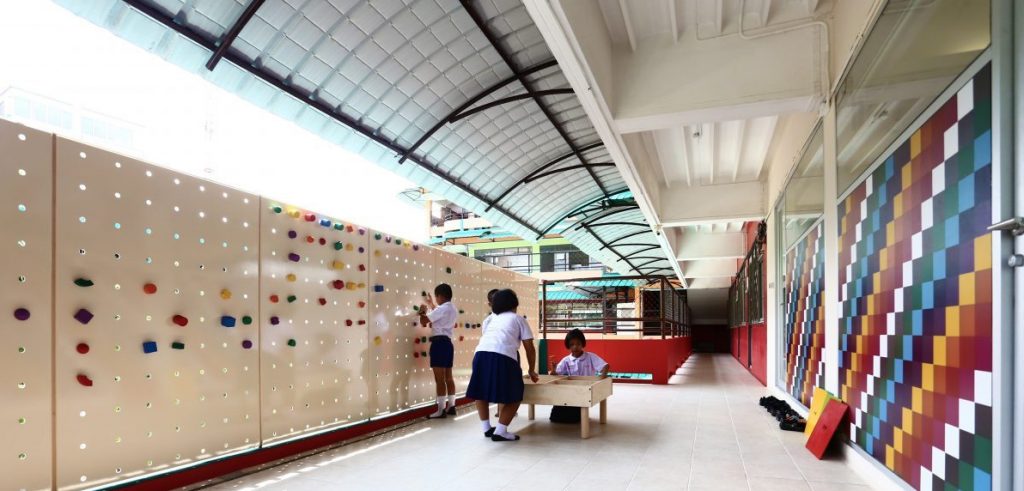THE RECENT COLLABORATIVE PROJECT BETWEEN DESIGNERS AND EXPERTS PRESENTS US A STATEMENT THAT: EDUCATION IS FOR EVERYONE
TEXT: TUNYAPORN HONGTONG
PHOTO: PICHAN SUJARITSATIT EXCEPT AS NOTED
(For Thai, press here)
With tactility being the key to learning, a 48-square meter classroom inside Pattaya Redemptorist School for the Blind used to have shelves full of books, which was a far cry from what could be considered a suitable learning experience for students with visual impairment. The children used to be seated on the floor and learnt from what the teachers would say, or through special textbooks for the blind. Having realized the conditions, and aspired to help develop the learning ability of the visually impaired students in Thailand, Golden Land Property Development PLC initiated the project, Classroom Makeover for the Blind. A collaboration between the real estate development company, the architects of Creative Crews and experts from various fields of study including Manisara Palawat, an academic from the Ministry of Education and expert on educational curriculum for the visually impaired.
Creative Crews transforms the floor and walls of the classroom into blackboards, functioning as one of the children’s learning tools. The space is designed to better attract the intention of the young users for its ability to motivate and encourage the children to freely move their bodies and enjoy the learning experience. The new floor comes with special textural details, enabling everyone to move around and experience the space through touch. “We find that in a normal classroom, several students who are visually impaired would usually come in, sit down, either putting their faces on the ground or leaning on to the wall almost most of the time. They would usually refuse to touch or hold anything because they were accustomed to being constantly assisted. They are fearful for the possible danger by moving their own body. There are cases where these students would only move if they were in a room padded with soft surface. It’s a safe environment but it’s the kind of environment that is nowhere near the real world where they have to actually live in.” The team of architects from Creative Crews told art4d how they use perforated aluminum sheets as the material of the classroom’s walls, including the area at the corridor. Installed on these sheets, are ‘learning pins’, the work by Waritta Pholcharoen, designer specialized in toys for children’s development from PlanToys. The pins come in geometric forms, with both big and small sizes, light and heavy in weight, some come with and without sounds, some with rough textures while others are soft. There are also the more complicated animal-shaped pins which do not only help the children learn on their own, but also stimulate conversations and discussions among the group. The walls where the pins are installed start from the corridor in front of the classroom, implying that learning can take place anywhere, even outside the space of the classroom.

Photo courtesy of Creative Crews
Another brief the team of Creative Crews was given from MANA Agency who oversees the project is that the classroom needs to be flexible and allows for the lessons to be constantly updated. The architects designed the learning pins to be removable, which means the students can learn different subjects without the need to switch classrooms. Additionally, two sides of the walls can be used to store all the learning tools for the sound wave subject, breathing exercise, light beam subject, etc., Every detail is curated to render and enhance the children’s learning experiences through their different physical senses, which are all important for how they will be living their lives in the future.

Photo courtesy of Creative Crews
Lastly, two of the most important issues which the design is expected to deliver are, the simplicity of the construction and the cost. Golden Land wished for Classroom Makeover for the Blind to serve as a prototype classroom that will be constructed in other schools nationwide. Creative Crews chooses materials for their affordable price and availability, and most of them come with the textures and physical forms that users are familiar with. The learning tools are everyday objects such as brushes, old fabrics, carpets, dolls and plastic items that are not only easily replaceable but also something the children can already recognize.

Photo courtesy of Creative Crews
Thanks to the low construction cost and uncomplicated construction methods, the facility that provides fundamental education for the visually impaired is no longer reserved for those who are able to afford it. People from all economic statuses are now able to receive basic education in the way it should be. It gives hope to the possibility that the surprisingly low number (15%, to be exact) of the visually impaired population in Thailand with the ability to access basic education will finally see a potential growth in the future.




